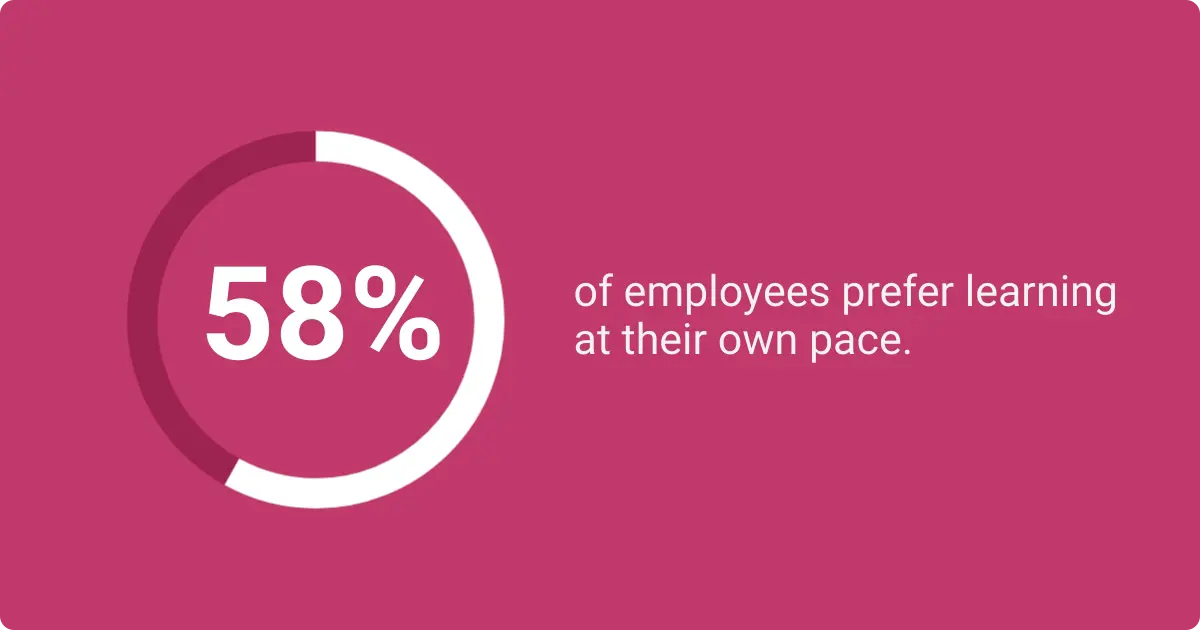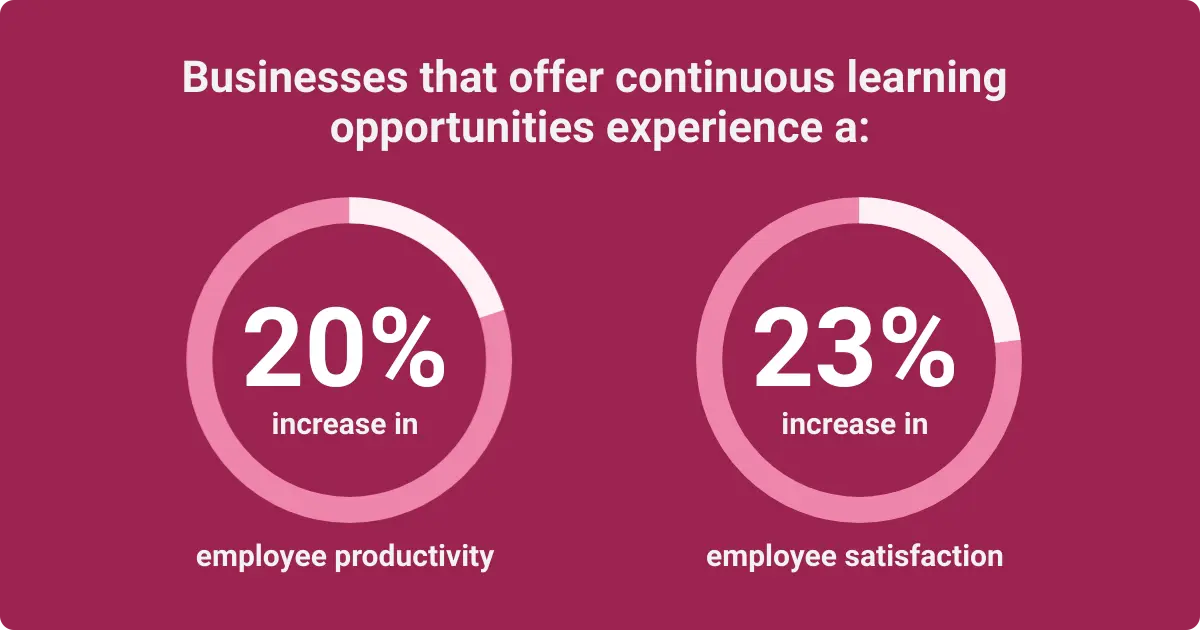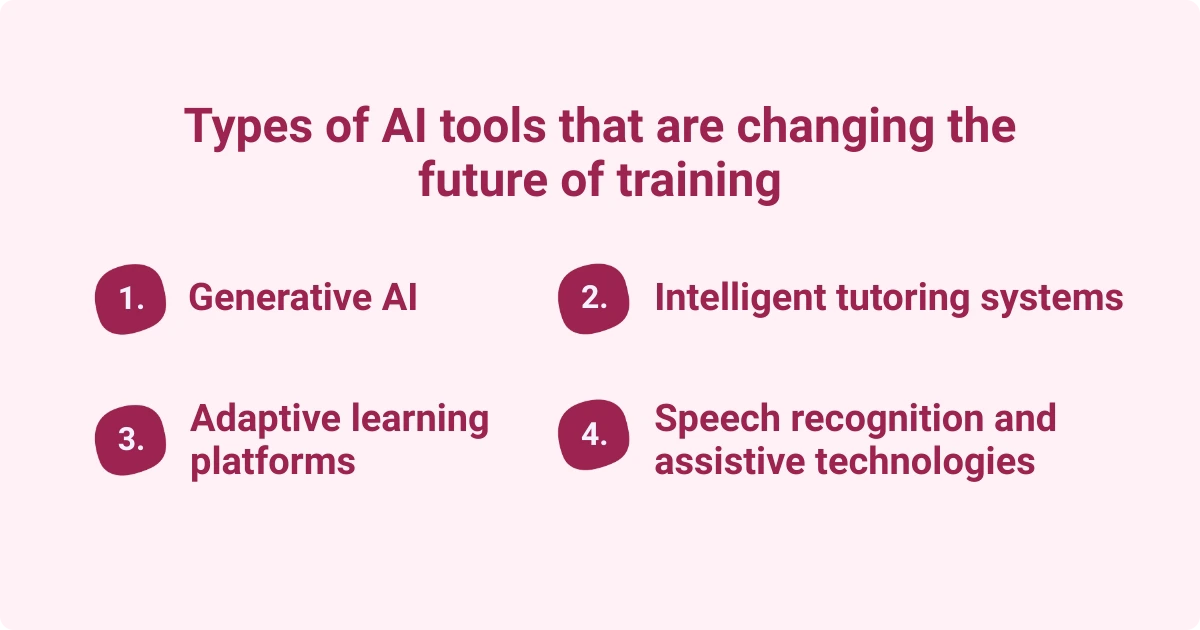How AI for Training and Development Is Transforming Corporate Learning Strategies
Table of contents

The evidence is clear: American workers are eager for professional growth. According to a TalentLMS and Vyond survey about key learning and development trendsOpens in a new tab, 66% of employees believe they must gain new skills to thrive in their roles. Additionally, 41% plan to change jobs within the next year if their current employer fails to provide training.
However, training employees involves more than hosting occasional workshops or sharing educational videos. Developing a quality program requires money, time, and the ability to personalize learning content. That’s why many businesses are turning to AI for training and development, where they are using artificial intelligence (AI) tools to create more effective training solutions.
From content generation to gamification, the use of AI in the workplace offers numerous ways to enhance employee development and training. Read on to discover how this innovative technology can help grow your employees’ skills.
How can my organization use AI in learning and development?
Let’s face it: traditional workplace training can be boring at best and downright painful at worst. Even the most enthusiastic employees don’t want to sit through long-winded videos or absorb irrelevant information.
Here are six key use cases for companies using AI to make training and development more engaging and valuable:
1. Creating personalized learning opportunities for every employee
Employees have diverse learning styles and needs. Some might quickly grasp written information, while others need hands-on activities to master new skills.

AI training platforms can use algorithms to analyze learner data and automatically adapt to each user’s needs, it also helps to build the train the trainer training program. For instance, if an employee struggles with a concept, the program could adjust the delivery method or generate review materials. By contrast, a more advanced learner could skip content they’ve already mastered.
By prioritizing employee-driven learning, AI in employee engagement and training tools can significantly improve performance and retention. A recent literature reviewOpens in a new tab of AI in education found that “personalized learning experiences lead to increased student engagement, motivation, and a deeper understanding of the material.”
2. Providing AI-driven assessments and feedback in real-time
According to Gallup's book, Culture Shock, 80% of employees who received meaningful feedback within the previous week were fully engaged at work. However, only 16% reported that their most recent conversation with their manager was extremely meaningful.
AI tools for training and development can help fill this gap by giving learners immediate, personalized feedback. This could involve highlighting employees’ strengths and offering targeted recommendations for improvement. With frequent and specific feedback, employees can achieve their goals more effectively and stay motivated to keep learning.
Companies can also use automated assessments for skills evaluation. These tests identify areas where employees may need additional training or resources to improve their performance. For example, if most of your team lacks data analytics skills, you could provide access to a related online certificate program.
3. Tracking skill gaps and promoting continuous learning
According to a 2024 whitepaper by the Association for Talent DevelopmentOpens in a new tab, 74% of training and development professionals believe their organization has skill gaps in the workplace. You may assume that lower-level employees are the main contributors, but that’s not always the case. Nearly half (48%) of respondents reported that managers, supervisors, and team leaders also have major skills gaps.
AI for management offers an effective and objective way to pinpoint these skill gaps. This technology allows you to track your team’s performance and recommend areas of development. For instance, machine learning algorithms can analyze anonymous employee surveys to uncover communication or management deficits among team leaders.
Make smarter development decisions using the combined powers of AI and recognition—Human Intelligence™—to crowdsource authentic, sustainable skills insights.
Workhuman's latest product innovationOpens in a new tab helps you easily map and track employees' skills using recognition data. Identify gaps or find employees already recognized for key skills using the AI Assistant. Use open-ended prompts to answer questions like “Who on my team is qualified for X?” or finding potential mentors.
Armed with these AI-powered insights, you can continually adapt your learning process to meet your workforce’s changing needs. One quarter, you might focus on strengthening your employees’ leadership skills, while the next is all about improving public speaking. These continuous learning opportunities can improve employee productivity and performance.

4. Improving training efficiency and reducing operational costs
Developing or outsourcing training and development programs can be expensive. In 2024, U.S. businesses with over 100 employees spent $98 billion on training.
AI tools can drastically reduce the costs associated with traditional training processes. This technology can complement or take the place of human trainers, saving on payroll costs. Online platforms also eliminate the need for physical materials like handouts and textbooks, which can be costly to print – and add more waste to the environment.
On top of that, AI technologies make training more efficient. For example, natural language processing (NLP) tools like ChatGPT can generate educational content much faster than humans. Meanwhile, machine learning algorithms can automate repetitive tasks, such as grading quizzes or sending out reminders. While these changes might seem small at first, they add up to significant savings over time.
5. Boosting learner engagement and performance
You’ve probably slogged through a dense textbook or zoned out during a boring lecture. These old-fashioned training methods often fail to capture employees’ attention or keep them engaged.
Leverage AI to create engaging, immersive learning opportunities. For example, chatbots can engage learners in lively conversations and guide them through training material.
Simulations let participants practice applying new skills – like pitching products to reluctant buyers – in a low-stakes environment.
By adding interactive elements, you’ll transform training from a tedious chore into a fun and productive experience.
6. Developing gamified learning experiences with AI
If you’ve ever lost track of time playing Pokemon or Final Fantasy, you know just how addictive video games can be. Gamification uses the same elements to make the learning experience more engaging and interactive.
AI-powered platforms like Centrical and Docebo make it easy to add gamification elements to workplace training. For example, you can use badges to celebrate when employees reach learning milestones. Meanwhile, leaderboards can turn training sessions into spirited competitions between coworkers.
Combining AI with augmented or virtual reality tools can also make learning more fun. Noda, for instance, allows users to create 3D mind maps in virtual reality and then ask the built-in AI to help brainstorm ideas.
At first, gamification might seem a bit silly — especially if you’re used to old-fashioned training techniques — but it’s a powerful interactive learning tool. According to an Educational Psychology Review meta-analysisOpens in a new tab, gamification can improve cognitive learning outcomes, increase motivation, and aid skill development.
Types of AI tools that are changing the future of training
Artificial intelligence tools have already made their way into workplace training, with even more advancements on the horizon. Here are four AI applications transforming how businesses train their workers:
1. Generative AI
Generative AI tools can create custom training content in seconds. Simply input a detailed description of your needs, and the AI will produce tailored materials. For instance, you could upload your company handbook to ChatGPT and request a 10-question quiz or a review guide covering key policies.
Popular generative AI tools include:
- ChatGPT for written materials like case studies, exams, and FAQs
- Canva AI for visual content, such as posters and storyboards
- Invideo for training videos, complete with music and voiceovers
- Articulate 360, a learning management system for interactive courses
These platforms can help you brainstorm fresh ideas and make your training materials more engaging. For example, you could use ChatGPT to write custom growth and development plans for each employee, then turn to Invideo to create personalized AI video content. This strategy will save time and help you maintain a steady stream of training content.
2. Adaptive learning platforms
There’s no one-size-fits-all approach to learning, especially when it comes to developing complex skills. Adaptive learning solutions use AI to evaluate learner data, such as demographics, learning styles, and skills gaps. These insights allow the systems to personalize content for more effective training.
SC Training is a popular adaptive learning tool for businesses. Users can build a custom course in minutes, using either a convenient template or the Create With AI tool. The system also uses spaced repetition to automatically reinforce content until the learner masters it.
Similarly, Whatfix analyzes user interactions and delivers walkthroughs or tips as needed. This flexibility gives employees tailored support exactly when they need it, improving learning outcomes and decreasing frustration.
3. Intelligent tutoring systems
Like human tutors, intelligent tutoring systems (ITS) offer one-on-one feedback and guidance. These computer programs use AI to personalize teaching methods based on the user’s learning style.
While using ITS isn’t common in workplace training yet, there are a few options available for students. For instance, Answer.AI tutors students in subjects like biology, history, and math. The application provides step-by-step explanations and adapts to individual learning styles. Likewise, Khanmigo encourages students to think critically by asking questions and giving helpful tips instead of automatically giving away the answers.
4. Speech recognition and assistive technologies
AI technologies can make workplace training more inclusive for employees with disabilities. For example, speech recognition tools like Otter.ai and Voiceitt use AI to accurately interpret spoken language and convert it to text. This software allows people with hearing impairments, speech impediments, and other disabilities to participate more fully in training.

Major challenges of using AI in L&D programs
Like any new technology, artificial intelligence has potential drawbacks. Here are a few challenges your organization may face as you add AI tools to your training programs. Some of those obstacles may include the following:
The initial cost of implementation
While AI tools can save money in the long term, some platforms come with significant upfront costs. Your business may need to upgrade its hardware, invest in new software, and offer training to help employees use these tools effectively. To overcome this roadblock, consider starting small with an affordable AI tool or choosing a vendor who offers free training.
Reduced human interaction
AI learning platforms offer convenience and flexibility, but they can also lead to fewer opportunities for face-to-face interaction. Maintain the human element by creating mentorship programs or offering collaborative, in-person training workshops to complement your AI offerings.
Creating an AI learning ecosystem
It’s relatively easy to add one or two AI tools to your training programs – just apply them to specific classes or development sessions. However, creating a seamless, AI-powered learning ecosystem is much more challenging. Platforms may not mesh with your existing tech stack, or employees may have radically different training experiences across departments.
Set yourself up for success by choosing AI technologies that integrate with your current systems. For example, ChatGPT is compatible with Slack, so you can add it to your communication workflows. Establishing company-wide training standards and using the same tools across departments will also help you create a consistent learning experience.
Aligning AI tools with your goals and objectives
With so many AI technologies available, many companies struggle to choose ones that best suit their goals. For instance, you may wonder if ChatGPT can fix your skills gap or if an e-learning platform like Articulate 360Opens in a new tab would work better.
To overcome this common challenge, define your goals and search for tools with relevant features. Once you’ve identified a few promising options, ask the vendors for product demonstrations to see how their platforms can address your needs. This practical approach will help you choose tools that will actually help you accomplish your goals — instead of following the latest tech trends.
Addressing data privacy and ethical concerns in AI
Do you notice that your team members seem apprehensive or concerned when you mention AI? They might worry that their data could get leaked or used against them.
Handling learner data responsibly is key to protecting your employees and getting buy-in. Avoid bias by anonymizing learner data whenever possible, and practice transparency by explaining how you use this information. And, of course, you should choose tools that comply with relevant privacy regulations, such as the General Data Protection Regulation (GDPR).
Real-life examples of companies using AI for training and development
Using AI in learning and development may still seem like something out of a science fiction movie, but many organizations have already begun using these tools in their training programs.
In 2020, Johnson & Johnson used a large language model to assess its technologists’ performance for 41 future-ready skills. Participants could use this data to benchmark their skills and were more likely to take advantage of self-learning resources to improve their proficiency.
Similarly, MineralOpens in a new tab used ChatGPT to help employees develop generative AI skills. The company divided workers into learning communities that worked together to experiment with the tool and complete training exercises.
The future of AI for employee development and training
In the next five to 10 years, AI advancements will continue to revolutionize workplace training. This technology will allow companies to create hyper-personalized learning programs, helping employees advance their careers or explore niche interests. Cohort learning may also gain popularity as experiential learning environments grow more sophisticated and capable of supporting multiple users working in tandem.
See also: AI and the Future of Work: How Emerging Technologies Are Reshaping the Workforce
Wrapping up
As technology advances at a blistering pace, companies are racing to address widening skills gaps at every level. Using AI for training and development will allow you to provide highly engaging, personalized opportunities for learning. The best part? Your employees will actually want to participate in these AI-powered programs.
You don’t have to revamp your entire employee training curriculum overnight. Start small by launching a pilot program that focuses on one or two critical skills. As your staff members grow more comfortable with AI training courses, you can expand your toolkit to support their professional development more effectively.